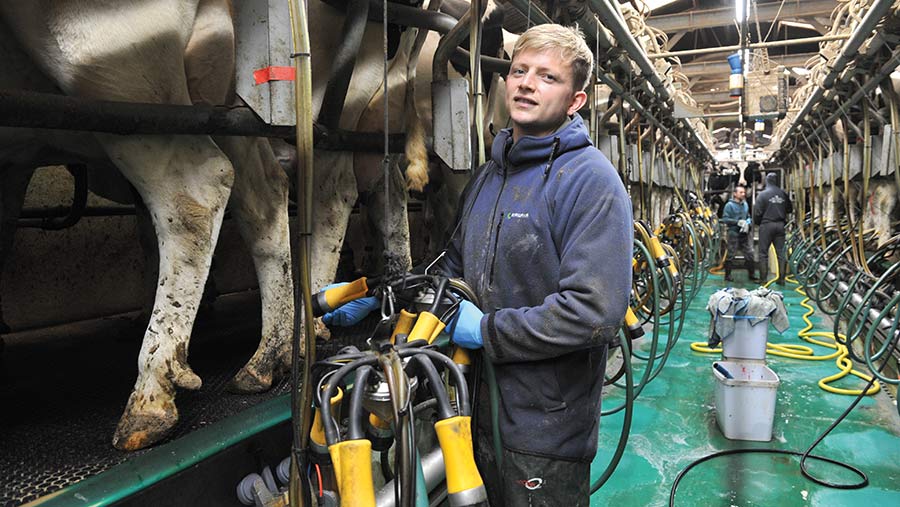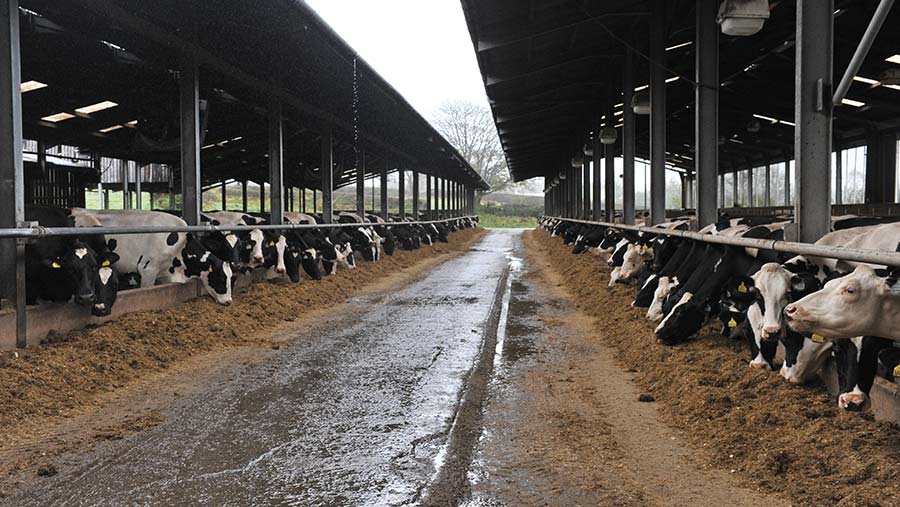Switch to three times a day improves yields by 2,000 litres a cow
 Charlie George in the milking parlour
© Debbie James
Charlie George in the milking parlour
© Debbie James When the George family increased milking frequency they realised an uplift in milk yield of 2,000 litres a cow.
As pedigree Holsteins, the cows were already high yielding, producing an annual average milk yield of 11,000 litres a cow a year from twice-a-day milking.
Switching to three-times-a-day and making the system fully housed increased that figure to an average of 13,000 litres a cow, helped by genetics and improved fertility and nutrition management.
Dairy producers who move from twice to three-times-a-day milking can expect an average yield uplift of 15%, says Michael George, who admits the increase was much higher than anticipated.
On average, cows at Brynhyfryd are producing 12% more and heifers 20%.
“For us, that is worth around £600 a cow a year in milk income and, even when the extra costs are taken into consideration, we are seeing an improvement in our profit margin a cow.”
See also: What to consider when switching to three-times-a-day milking
About the operation
The George family run two high-yielding herds at Wolfscastle, Pembrokeshire; both are fully housed and milked three times a day.
Michael runs the herd at Brynhyfryd with his wife, Jill, and their youngest son, Charles, while the second herd, at nearby Sealyham Farm, is run by his brother and sister-in-law, Rowland and Sharon, and Michael and Jill’s eldest son, James.
James and Charles are responsible for the day-to-day management of the herds.
Continuous housing and frequent milking suit the high-performing Holstein cow that the Georges are renowned for.
They increased milking frequency 11 years ago after seeing it operating successfully on other farms.
Farm facts
- 890ha (2,198 acres) owned and rented land
- Cows yielding 13,000 litres a cow a year at 3.8% butterfat and 3.3% protein
- Heifers inseminated with sexed semen
- Milk sold to Dairy Partners
Genetics was instrumental in allowing them to make the switch. “The potential of the dairy cow is now much higher and milk yield has vastly improved,” says Mr George.
“We have utilised genetics; our cows have the ability to produce high volumes of milk. On a high-input system, milking more frequently will give you more milk.”
That is particularly true of heifers that are milked three times a day, he adds.
“Heifers have smaller udders than cows so have less capacity to carry milk, so the more often they are milked, the more milk they can produce in a day,” says Mr George.
It is good for cow health and welfare too, he suggests.
“There is less pressure on cows because they are carrying less milk, and that means fewer udder health challenges. We no longer get milk leaching from the teat openings when the cows are lying in the cubicles, which can be an issue with high-yielding herds.”
Udder health and benefits
Somatic cell count (SCC) readings are running at an average of 180,000 cells/ml.
Another benefit of frequent milking is that there are three opportunities to observe the cows every day, and that is good for cow welfare too, says Mr George.
“There is always someone on duty. We see the cows more than we did when we were milking twice, and there are always people around at calving.”
Labour challenges and shifts
On the flip side, labour can be a major challenge and is the reason why many dairy farms are now abandoning three-times-a-day milking.
The Georges employ 20 full-time staff and five part-timers – a blend of local and overseas workers. At both farms, milking starts at 3.30am, 11.30am and 7.30pm, with cows milked through 40:40 herringbone parlours.
The cows are run in groups, according to lactation, to minimise the length of time they stand during the milking period.
At Brynhyfryd, each milking takes six hours and there are six groups which means that each cow only stands for an hour.
“The sustainability of the system all comes down to labour,” admits Mr George, who adds: “Getting good staff to make it work is the biggest difficulty and for many, that is where it ends – when you can’t get the right type of staff and run out of labour options.”
At Brynhyfryd and Sealyham, most workers milk one shift a day, and never more than two.
There are three dedicated night milkers who share the night shifts.
Having good night milkers is important, says Michael. “The last thing you want is someone regularly ringing you at midnight.”
Running a night shift on a farm is normal in many sectors, including healthcare and policing, and agriculture is no different, he adds.
In the first year of three-times-a-day milking, Mr George milked all three shifts, and not because he was short of labour.
“I couldn’t accept that I didn’t need to be there for every milking, but I had to let that go.”
The Georges value their staff and make every effort to retain them.
“We have a good relationship with our staff. They are well-paid and conditions are good. Gone are the days when agricultural work was low paid,” explains Mr George.

© Debbie James
Increased costs
Cost of production is inevitably higher with more frequent milking – Mr George calculates that labour and electricity costs are both 50% more expensive. But each farm has 100kW solar systems to meet its energy needs.
Feed costs are higher, too – cows that produce more milk need more to eat. But, producing top-quality grass and maize silage from 526ha (1,299 acres) and 202ha (498 acres), respectively, is helping them to manage these costs with purchased feed at 9.5p/litre.
A multicut silage system, introduced four years ago, is resulting in forage with a minimum of 11 metabolisable energy, 17% protein and a digestibility value more than 70.
The first cut is taken on 20 April and every 30 days thereafter, up to six cuts a year, but more typically five.
Straights are blended on-farm and fed through a self-propelled feeder wagon; these include rape, brewers’ grains, wheat, barley, ground maize and soya hulls, but will depend on what products are the most cost-effective.
The higher cost of production is the reason why scale is needed to make three-times-a-day milking sustainable, he reckons.
But Mr George believes three-times-a-day milking will have to be abandoned on many units owing to staff struggles.
“In the next year it will have to end for many because of labour shortages and that will be a disadvantage because businesses will be less profitable.
“It is not the best time to start at the moment because of the labour issue. When labour becomes more plentiful it is definitely a good option.”
Considering three-times-a-day milking?
- Ensure you have enough labour. It is unrealistic to do all three milkings yourself
- Having good night milkers is essential
- Consider the turnaround of cows at each milking. You need a system that runs very quickly to limit the stress on cows.
